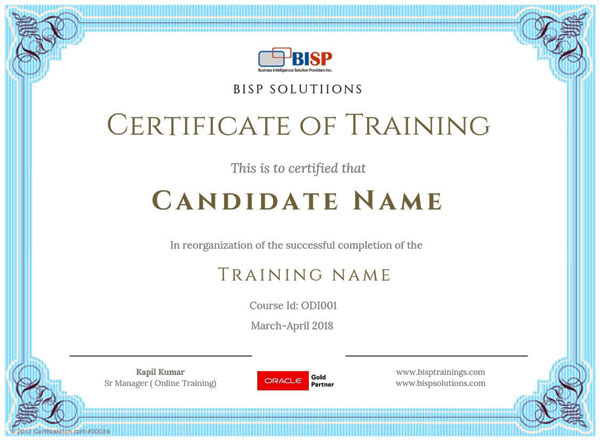Oracle Essbase and Planning and Budgeting Cloud Service Training
An Introduction to Multi-Dimensional Database
- Understating Multi-Dimensional Database concepts
- Dimensional Modeling Concepts
- Dimension and Fact
- Dimension Hierarchy
- Confirm Dimension
- Full and Semi additive Measure
- Star Schema, Snowflake schema, and galaxy model
- Operation on Multidimensional database
Essbase Overview
- Essbase
- Production Environment Components
Designing Applications and Databases
- Essbase Implementation Process
- Analyzing and Planning Implementations
- Creating Applications and Databases
Creating Outlines
- Data Descriptor Dimensions Overview
- Designing Time Dimensions
- Designing Scenario Dimensions
- Outline Calculations
- Designing Accounts Dimensions
- Testing Outline Calculations
- Creating Member Aliases
- Dimension Types
- Creating Period-to-Date Totals
- Dynamic Calc Members
- Enhancing Accounts Dimensions
- Optimizing Data Storage
- Attribute Dimensions Overview
- Adding Attribute Dimensions to Outlines
- Design Considerations
Creating Basic & Advance Dimension Build Rules Files
- Rules Files Overview
- Creating Dimension Build Rules Files
- Configuring Dimension Maintenance Settings
- Advanced Dimension Build Rules Files Overview
- Creating Shared Members
- Manipulating Fields
- Creating User-Defined Attributes
- Creating Attribute Dimensions with Rules Files
Loading Data
- Data Load Overview
- Freeform Data Loading
- Data Loading using Rule file
- Creating Data Load Rules Files
- Selecting and Rejecting Records
- Capturing New Members
Working with Essbase Integration Service
- Creating OLAP Model and Meta-outline
- Loading Metadata and Data using Oracle Database
- Working with Drill through reports
Working with Essbase Studio.
- Essbase Studio Deployment Architecture
- Data Source Connections
- Metadata Elements and Alias Sets
- Working with Minischemas
- Hierarchies
- Cube Schemas
- Essbase Models
Working with Essbase Spreadsheet client
- Configuring Essbase Spreadsheet client
- Understanding various Essbase Client Options
- Writing Queries, Member selections, Drill Down, Drill Up, Keep the only remover only, etc
Data Storage and Calculation
- Calculation Overview
- Database Calculation Order
- Data Block Fundamentals
- Data Blocks and the Index System
- Interpreting Database Statistics
- Data Block Creation
- Database Calculation Process
Creating Calculation Scripts
- Calculation Script Organization
- Returning Correct Calculation Results
- Troubleshooting CALC DIM Processes
- Top-Down Calculation
- Focusing Calculations with FIX Statements
- Calculating Conditionally with IF Statements
- Performance Considerations
- Referencing Members Dynamically
- Creating Calculation Variables
- Developing and Testing Complex Calculation Scripts
- Implementing a Script Development Process
- Upper-Level Data Loads
- Intelligent Calculation
Essbase Security Overview
- Essbase Native Security
- Global Access Security Layer
- User and Group Security Layer
- Application Access Type Security
- The Essbase Security File
Optimizing Block Storage Caches
- Optimizing the Database
- Optimizing Caches
- Setting RAM Caches
- Cache Hit Ratios
Essbase Automation using MaxL
- Understand the MaxL script structure.
- Automate Metadata, Data Load Process
- Automate Calculation and consolidation process
- Automate Data Export Using Report Script and Data Export Command
Essbase Optimization and Memory management
- Optimizing the Database
- Optimizing Caches
- Setting RAM Caches
- Cache Hit Ratios
Analyzing Text and Dates
- Typed Measures Overview
- Enabling Typed Measures
- Creating Text Measures
- Creating Date Measures
- Viewing Typed Measures
- Calculations Based on Typed Measures
Hyperion Planning
- Hyperion Planning Overview
- Creating Hyperion Planning Classic Application and EPMA Application Part I
- Creating Hyperion Planning Classic Application and EPMA Application Part II
- Dimension Overview and their properties
- Loading Data and Calculate the Database
- Setting up Security
- Designing Data Form
- Entering Data in Data Form
- Migrating Planning using LCM Ulitility[Setting Up Application Setting]
- Creating Planning Task List
- Planning Process Management
- Working with Business Rule
Aggregate Storage Overview
- Aggregate storage key characteristics and design considerations
- Key differences between ASO and BSO design
- Understanding the aggregate storage production cycle
- Creating aggregate storage outline hierarchies
- Loading Data
Getting Started with Smart View
- Navigating Smart View
- Connecting to Data Sources
- Creating Ad Hoc Grids
- Setting the Point of View
- Associating Data Sources with Worksheets
- Creating Free-Form Grids
Creating Reports with Smart View
- Updating Essbase Data
- Integrating Essbase Data with Microsoft Office
- Creating Shared Database Perspectives
- Creating Custom Reports
Get started using Oracle Planning and Budgeting Cloud
- Use Oracle Planning and Budgeting Cloud to complete the business budgeting and forecasting process
- Configure, test and maintain the components of a Planning application
- Set up the Planning application with dimensions, aliases, currencies and time periods
- Set up Planning and Budgeting scenarios and versions
- Load metadata and data
- Implement security and manage users
- Implement business rules and processes
- Manage the approval process, which includes moving a plan through the budget review-and-approval process
- Create and enhance forms for user input

